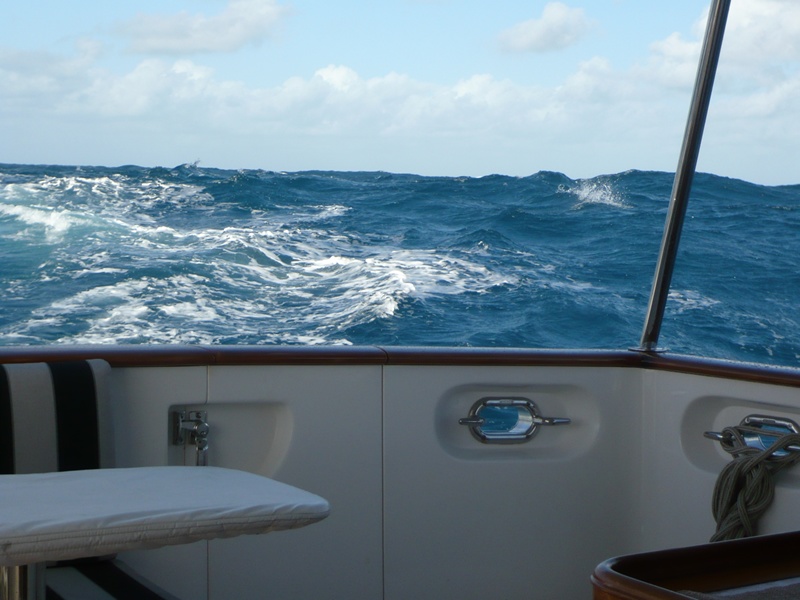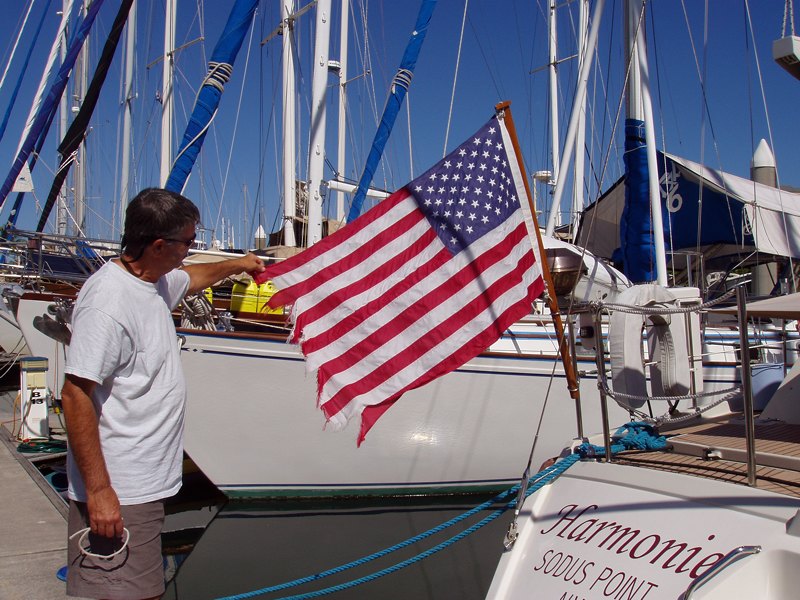Crossing the Gulf of Carpentaria - Two Island Bay, Marchinbar Island, Northern Territory, Australia

Harmonie
Don and Anne Myers
Thu 22 Jul 2010 03:23
|
11:05.497S 136:43.448E
We left Seisia on June 20th and set out on our
first overnight passage of the season. Amazing to think that we had been
sailing since April and hadn't been through the pain and suffering of an
overnight passage yet. Yes, and there was some pain and suffering as
you'll see.
The following paragraphs were written right after we finished the 45 hour,
350 mile passage, but this entry was never completed until now - sorry for
the delay in posting it.
Well. That was something. The Gulf of
Carpentaria crossing is known for its strong southeasterlies and its
choppy, confused seas. So, when we left our calm anchorage next to the
small outback town of Seisia on the western side of Cape York Peninsula at noon
on a sunny day (6/20/2010), we knew the pleasant conditions wouldn't
last.
There was a strong wind warning in effect when we
left, indicating winds of 20-30 knots in the northern part of the gulf.
Unfortunately, the weather forecast was the same for the foreseeable future (as
it had been for the previous week), so we decided to go for it anyway. The
trouble with this part of the world at this time of year is that the trade winds
are relentless. We sailors like a good bit of wind, but 30 knots is about
10 more than what we really need. Storyteller needs a whole lot less
wind, so you can imagine how they felt about a two-day crossing in 30
knots.
Speaking of Storyteller, it was about 6pm on the
first day as Don was reporting our position to Storyteller on the SSB
(single sideband radio) when the wind kicked up from 15 to 22 knots.
A few hours later and it was blowing the full 30 knots in hurried puffs and
gusts of heavy, humid air. Once we got used to the howling through the
rigging, the wind wasn't so bad given that it was well behind the beam at
about 120 degrees off our bow. It was the steep, choppy waves that made
life ugly. The Carpentaria Gulf is very shallow, the eastern part is 20
meters deep or less. So in 30 knots of wind, the waves build up fast,
steep and short - meaning there is very little distance between peaks.
This is very unlike the typical ocean swell, which is generally spaced
widely enough apart for a sailboat to semi-comfortably sail up and down without
getting bashed around. Keep in mind that we had just spent the better part
of five weeks day-sailing placidly through waters protected by the Great Barrier
Reef, where even in 30 knots of southeasterly trade winds, the waves
struggled to reach a puny height of 3 feet.
So, in 30 knots of wind over 20 meters of shallow
water, surrounded by hot and humid dark air lit by a half
moon occasionally peaking through the cloud cover, we sailed through our
first night of the season. The waves built to a very
uncomfortable 10-12 feet, and took pleasure in bashing us
around. If one caught us square on the port side, we would
tilt sideways until we slid down the other side. Generally the tilts were
within reason, but one or two tilts went way beyond the norm and just when
we started to realize just how tilted we were as we hung on to the steel
tubing armrests on the helm seat, the boat righted itself in time for
the next wave. In some of the worst of it, I was on watch while Don was
attempting to sleep when we caught a wave square on the port side and it
broke over us. The entire length of the boat was dowsed in a wall of salt
water that bubbled simultaneously over the port bow, windshield, dodger,
back half of the cockpit and port side of the stern. It seemed like
an hour before I could see clearly out the windshield again, although it was
probably only seconds. It was worse than the worst rain storm in a car and
I felt blind with that mass of saltwater pounding down. When it stopped
and the boat righted itself, I looked around to be sure we were still headed in
the right direction (we were off course, but the autopilot was working hard to
put us back on track), then I surveyed the immediate area and checked my
clothing. I found only a mist of saltwater on my life jacket and
nothing else. The offset Amel helm seat tucked under the port side of the
hard dodger served its purpose yet again. Luckily nothing splashed down
the companionway either. A dowsing of saltwater would be all it would take
to kill the prized MacBook we use for navigation, which sits on the
chart table near the stairs to the cockpit. After that little episode,
none of the rest of the waves seemed threatening at all. This is the good
thing about sailing. The first time something happens, it might seem
scary, but the following hundred times are no big deal. Same thing
with the wind - the first hour or two of 30 plus knots might sound like a
howling scream, but several hours later you can almost convince yourself
it's semi-pleasant background music. Almost.
As the night went on we sailed into deeper water
and the waves started to even out and behave themselves. By noon the next
day the wind was down to a more reasonable 20-25 knots and the 33 knot gusts of
the night before were no longer. The beauty in all of this was that the
wind was well behind us the whole time (110-150 degrees off the bow), and
we sailed really, really fast. By dawn on the third day we
rounded Cape Wessel and turned southwest around the end of the island group,
sailing once again in flat water in the lee of the islands. The
dreaded Gulf of Carpentaria crossing was done and by 8:30 that morning we were
anchored behind flat Marchinbar Island in Two Island Bay with Storyteller beside
us. We slept very well that night.
Picture 1 - One of the famous Gulf of Carpentaria waves rearing up behind
Storyteller (another photo by Helen).
Picture 2 - Don displaying our tattered flag
after our arrival in Darwin. The flag was in good shape when we
left Scarborough Marina on April 17th, and still looked pretty good in
Seisia. It was the Gulf crossing that did it in.
Anne |

